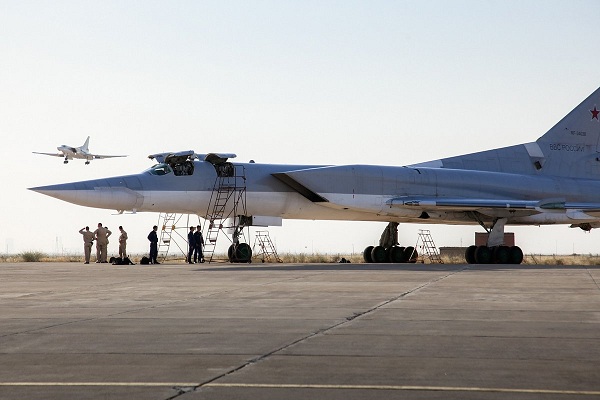Autumn Is Coming. Russian VKS in Iran
In
Login if you are already registered
(no votes) |
(0 votes) |
Ph.D. in History, Scientific Advisor of The Evgeny Primakov Center for International Cooperation, Senior Research Fellow, Center for the Arab and Islamic Studies, Institute of Oriental Studies RAS
Russian Aerospace Forces (VKS) warplanes have been deployed in Iran’s Hamadan, according to media reports on 15 August 2016 . The move followed the meetings between the leaders of Russia and Iran at a summit in Baku, leaders of Russia and Turkey at a summit in St. Petersburg, and heads of Foreign Ministries of Iran and Turkey. Therefore, there is a chance that the deployment of the Russian TU-22M3 strategic bombers at Iran’s 3rd Tactical Air Base in Hamadan had been coordinated in advance. Previously, those aircraft had been involved in the Syrian operation of the Russian VKS, flying from Russian Mozdok in North Ossetia.
The Hamadan air base is located in western Iran and is used exclusively for military purposes. Unlike other military air bases of the country, the 3rd Tactical Air Base does not accept civil aircraft. The air base is considered to have state-of-the-art equipment and has a 4,600-meter runway. A TU-22M3 strategic bomber requires from 2,000 meters to 2,200 meters to take off . The size of the Noje Hamadan air base and its capacity are its key advantages over the Russian Khmeimim Airbase in Latakia.
The redeployment from Mozdok to Hamadan will cut the travel time for Russian bombers by more than half (approximately by 60%, according to Arab sources). The move will allow having additional sorties, making them more efficient, and cut Russia’s expenditures.

twitter.com/@miladvisor
Strategic bomber Tu-22M3
The closest IS targets are in Iraq. However, Russia has not yet received any invitation or authorization from the government in Baghdad to engage in operations in that country. Therefore, it is expected that the Russian VKS task force in Hamadan will be used to bomb targets in Syria. Moreover, according to sources at the Ministry of Defence, Russia has filed a request for its cruise missiles to fly in the airspace of Iraq and Iran. Those two countries were reported to have given the green light. It appears that Russia may launch its Kalibr cruise missiles from the Caspian Sea, let alone from the ships of the Russian fleet in the Mediterranean.
The closest relevant directions for engagement from the Noje Hamadan air base are Palmira and Deir ez-Zor. However, the deployment of the Russian task force of strategic bombers in Iran must be associated with the upcoming all-out offensive on positions of anti-government extremist organizations near Aleppo and in its southwestern part should the negotiation process fail. Indirect evidence of this is that over the last two weeks, Iraqi militia were reported to be deployed in the area to support the Syrian Arab Army (SAA), the best-known paramilitary being Harakat Hezbollah al-Nujaba and Kata'ib al-Imam Ali. Lebanon’s Hezbollah has also built up its presence in Syria’s northern province. Overall, this activity can be perceived as Russia’s pressure on negotiating groups in Geneva, which can either serve as a push for the Syrian opposition to exercise a more serious and responsible approach to negotiations, or result in large-scale military operations. The latter seems more likely, because Jabhat Fateh al-Sham (formerly Jabhat al-Nusra, which two weeks ago declared that it had split from al-Qaeda) has been playing an increasingly important role as the ruling force in Aleppo, and representatives of the Syrian opposition coalition refused to meet with Deputy Foreign Minister of Russia Mikhail Bogdanov in Qatar’s Doha .
These developments have been taking place amid the ongoing assault of Iraqi troops on Mosul in the vicinity of al-Kaiyara and mop-up of ISIL troops in Manbij by the so-called Syrian Democratic Forces (SDF), backed by the U.S. The SDF are mostly represented by Kurds (and also include Kurdistan Workers' Party militants), with limited involvement of Arab troops. The takeover of Manbij by the SDF makes it possible to go on with the process of shutting access of the IS to the Turkish border. Nevertheless, the following pattern will likely emerge in the foreseeable future: the U.S. will be preparing areas inside Syria that are beyond control of the central government, which will require significant resources and investments by the U.S., whose main objective at the current stage is to make Turkey (which won’t have a Kurdish entity with ambitions for autonomy on its borders) put up with this pattern.
Even if Turkey fails to support Russia’s Aleppo campaign, the decision must have already been taken. Russia intends to completely suppress the groups that found themselves under blockade and have been trying to break it over the past two weeks. Russia is also reported to keep on working at the local level with some of the groups of the so-called Free Syrian Army, which is in opposition to Bashar al-Assad. Recruiting relatively moderate forces is an extremely important factor in crisis management. The situation remains complicated; however, if the Russian VKS are more actively involved, as it was in January and February 2016, and certain groups are withdrawn from their combat against pro-government Syrian forces through local negotiations, the situation may change drastically.
(no votes) |
(0 votes) |




